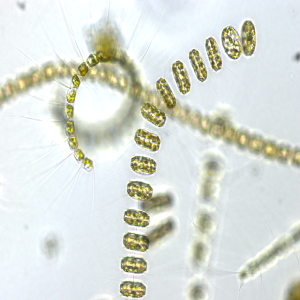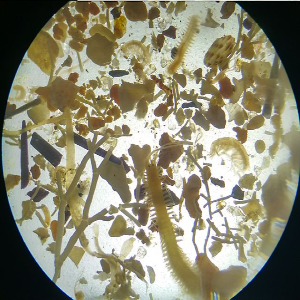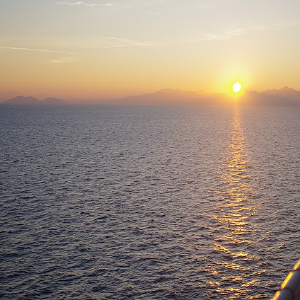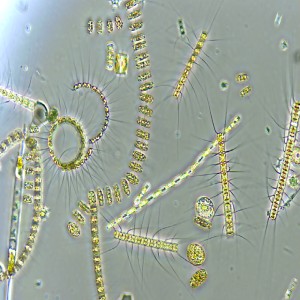Diet and isotopic metrics of predatory and prey fish in two estuaries with different degrees of anthropogenic disturbances: the case study of Wami and Pangani rivers in Tanzania
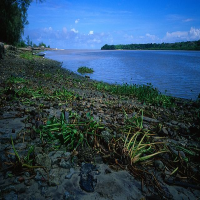
Accepted: 24 November 2021
Supplementary Materials: 0
HTML: 68
All claims expressed in this article are solely those of the authors and do not necessarily represent those of their affiliated organizations, or those of the publisher, the editors and the reviewers. Any product that may be evaluated in this article or claim that may be made by its manufacturer is not guaranteed or endorsed by the publisher.
Diverse anthropogenic activities including alteration of hydrological regime and agricultural development in the upstream of the river catchments modify the structural components and ecological roles of the species in estuarine ecosystems. The present study compared the diet, carbon (δ13C) and nitrogen (δ15N) isotopic signals, trophic niches and metrics of trophic redundancy of predatory fish and their potential phytodetritivore prey-fish between two estuaries with different degrees of anthropogenic disturbances. The δ13C and δ15N signals, Bayesian mixing models and stomach content analyses were adopted. It was revealed that the diet among the predators Arius africanus, Epinephelus coioides, Sillago sihama and Pomadasys argenteus and their isotopic signals including their phytodetritivore-prey, Valamugil buchanani were significantly different between Wami and Pangani estuaries (PERMANOVA, Pseudo –F ≥ 3.1, p = 0.05). The total isotopic niche area between estuaries accounted by the comparable Bayesian standard ellipse area (SEAb) was significantly smaller in Wami than that of Pangani (t-test, t = 4.3, p < .001). The ANOVA test further confirmed significant variation in SEAb among fish populations in two estuaries (F = 27.84, p < 0.001). The Layman metric indices of trophic diversity and redundancy of Wami estuary were substantially smaller than those observed at Pangani estuary. These findings mean that despite Wami estuary being under conservation status, the extent of disturbances in the upstream is high enough to induce the ecological changes at the base of the food web, subsequently cascading its effect up to the higher-order consumers of the ecosystem. As a result, the ecological redundancy and ecosystem complexity of Wami is somewhat compromised relative to that of Pangani estuary. Therefore, the degree of anthropogenic disturbances in river catchments affect differently the trophic niches of predatory and phytodetritivore fish and hence overall food web structures, trophic redundancy and complexity of estuarine ecosystems.
Abrantes KG, Barnett A, Bouillon S, 2014. Stable isotope-based community metrics as a tool to identify patterns in food web structure in East African estuaries. Funct. Ecol. 28:270-282.
Abrantes KG, Barnett A, Marwick TR, Bouillon S, 2013. Importance of terrestrial subsidies for estuarine food webs in contrasting East African catchments. Ecosphere. 4:14.
Anderson MJ, Gorley RN, Clarke KR, 2008. PERMANOVA+ for PRIMER: guide to software and statistical methods PRIMER-E.
Anderson EP, McNally C, Kalangahe B, Gutmann Roberts C, Britton JR, 2018. Quantifying trophic interactions and niche sizes of juvenile fishes in an invaded riverine cyprinid fish community. Ecol. Freshw. Fish 27:976-987.
Anderson EP, McNally C, Kalangahe B, Ramadhani H, Mhitu H, 2007. A rapid ecological assessment of the Wami river estuary, Tanzania. Available at: https://pdf.usaid.gov/pdf_docs/pnadn793.pdf : 38 pp.
Baeta A, Valiela I, Rossi F, Pinto R, Richard P, Niquil N, et al., 2009. Eutrophication and trophic structure in response to the presence of the eelgrass Zostera noltii. Mar. Biol. 156:2107-2120.
Beck MW, Heck KL, Able KW, Childers DL, Eggleston DB, 2001. The identification, conservation and management of estuarine and marine nurseries for fish and invertebrates. Bioscience 51:633-641.
Bianchi G, 1995. FAO species identification sheets for fishery purposes. Field guide to the commercial marine and brackish-water species of Tanzania. Prepared and published with the support of TCP/URT/4406 and FAO (FIRM) Regular Programme. Rome, Italy.
Bouillon S, Connolly RM, and Gillikin DP, 2011. Use of stable isotopes to understand food webs and ecosystem functioning in estuaries. In: Wolanski E, McLusky DS (eds.), Treatise on estuarine and coastal science, 7:143-173.
Carbonara P, Follesa MC, (eds.) 2019. Handbook on fish age determination: a Mediterranean experience. Studies and Reviews. FAO. No. 98. Rome, Italy : 192 pp.
Cole ML, Kroeger KD, Mcclelland JW, 2016. Effects of watershed land use on nitrogen concentrations and δ15 Nitrogen in groundwater. Biogeochemistry. 77:199-215.
Cummings DO, Buhl J, Lee RW, Simpson SJ, Holmes SP, 2012. Estimating niche width using stable isotopes in the face of habitat variability: a modelling case study in the marine environment. PLoS ONE. 7:e40539.
Davis AM, Blanchette ML, Pusey BJ, Jardine TD, Pearson RG, 2012. Gut content and stable isotope analyses provide complementary understanding of ontogenetic dietary shifts and trophic relationships among fishes in a tropical river. Freshw. Biol. 57:2156-2172.
de Carvalho DR, de Castro DMP, Callisto M, Moreira MZ, Pompeu PS, 2017. The trophic structure of fish communities from streams in the Brazilian Cerrado under different land uses: an approach using stable isotopes. Hydrobiologia 795:199-217.
Dierking BJ, Meyer AL, 2009. Short communication: prey regurgitation in the grouper Cephalopholis argus. J. of Appl. Ichthy. 25:600-602.
Donázar-Aramendía I, Sánchez-Moyano JE, García-Asencio I, Miró JM, Megina C, García-Gómez JC, 2019. Human pressures on two estuaries of the Iberian Peninsula are reflected in food web structure. Sci Rep. 9:1-10.
Eeden A, Mehta L, Koppen B, 2016. Whose waters? large-scale agricultural development and water grabbing in the Wami-Ruvu river basin, Tanzania. Water Altern. 9:608-626.
Elliott M, Whitfield AK, Potter IC, Blaber SJM, Cyrus DP, Nordlie FG, et al., 2007. The guild approach to categorizing estuarine fish assemblages: a global review. Fish Fish. 8:241-268.
Euzen O. 1987. Food habits and diet composition of some fish of Kuwait. Bull. Mar. Sci. 9:65-85.
FIU-GLOWS, 2016. Freshwater inflow requirements for Wami river estuary, Saadani National Park, Tanzania. : 104 pp.
García K, Sanpera C, Jover LL, Palazón S, Gosálbez J, Górski K, et al., 2020. Invasive mink does not drive trophic displacement of the native mink during an invasion process. Animals. 10: 1387.
Gibran FZ, 2007. Activity, habitat use, feeding behavior, and diet of four sympatric species of Serranidae (Actinopterygii: Perciformes) in southeastern Brazil. Neotrop. Ichthyol. 5:387-398.
Gillson J, 2011. Freshwater flow and fisheries production in estuarine and coastal systems: where a drop of rain is not lost. Rev. Fish Sci. 19:168-186.
Gutmann Roberts C, Britton JR 2018. Quantifying trophic interactions and niche sizes of juvenile fishes in an invaded riverine cyprinid fish community. Ecol. Freshw. Fish 27: 976-987.
Han R, Chen Q, Wang L, Tang X, 2016. Preliminary investigation on the changes in trophic structure and energy flow in the Yangtze estuary and adjacent coastal ecosystem due to the three Gorges reservoir. Ecol Inform. 36:152-161.
Harrison TD, Whitfield AK, 2006. Temperature and salinity as primary determinants influencing the biogeography of fishes in South African estuaries. Estuar. Coast Shelf Sci. 66: 335-345.
Hellar-Kihampa H, de Wael K, Lugwisha E, van Grieken R, 2013. Water quality assessment in the Pangani river basin, Tanzania: natural and anthropogenic influences on the concentrations of nutrients and inorganic ions. Int. J. River Basin Manag. 11:55-75.
Hoeinghaus DJ, Vieira JP, Costa CS, Bemvenuti CE, Winemiller KO, Garcia AM, 2011. Estuary hydrogeomorphology affects carbon sources supporting aquatic consumers within and among ecological guilds. Hydrobiologia. 673:79-92.
Hurlbert SH, 1978. The measurement of niche overlap and some relatives. Ecology 59:67-77.
Hyslop EJ, 1980. Stomach contents analysis-a review of methods and their application. J. Fish Biol. 17:411-429.
Jackson AL, Inger R, Parnell AC, Bearhop S, 2011. Comparing isotopic niche width among and within communities: SIBER – Stable Isotope Bayesian Ellipses in R. J. Animal Ecol. 80:595-602.
Jackson AL, Parnell AC, Inger R, Bearhop S, 2011. Comparing isotopic niche widths among and within communities: SIBER - Stable Isotope Bayesian Ellipses in R. J. Anim. Ecol. 80:595-602.
Kiwango H, Njau KN, Wolanski E, 2015. The need to enforce minimum environmental flow requirements in Tanzania to preserve estuaries: case study of mangrove-fringed Wami river estuary. Ecohydrol. Hydrobiol. 15:171-181.
Kiwango H, Njau KN, Wolanski E, 2018. The application of nutrient budget models to determine the ecosystem health of the Wami estuary, Tanzania. Ecohydrol. Hydrobiol. 18:107-119.
Kostecki C, Le Loc’h F, Roussel JM, Desroy N, Huteau D, Riera P, et al., 2010. Dynamics of an estuarine nursery ground: the spatio-temporal relationship between the river flow and the food web of the juvenile common sole (Solea solea, L.) as revealed by stable isotopes analysis. J. Sea Res. 64:54-60.
Kroetz A, Drymon JM, Powers SP, 2016. Comparative dietary diversity and trophic ecology of two estuarine mesopredators. Estuaries and Coasts. 40:1171-1182.
Kulbicki M, Bozec Y, Labrosse P, Letourneur Y, Mou-tham G, Wantiez L, 2005. Diet composition of carnivorous fishes from coral reef lagoons of New Caledonia. Aquat. Living Resour. 18:231-250.
Layman CA, Araujo MS, Boucek R, Hammerschlag-peyer CM, Harrison E, Jud ZR, et al., 2011. Applying stable isotopes to examine food-web structure : an overview of analytical tools. Biol. Rev. 87:545-562.
Layman CA, Arrington DA, Montana CG, Post DM, 2007. Can stable isotope ratios provide for community-wide measures of trophic structure? Ecology 88:42-48.
Lira A, Angelini R, Le Loc’h F, Ménard F, Lacerda C, Frédou T, et al., 2018. Trophic flow structure of a neotropical estuary in North-Eastern Brazil and the comparison of ecosystem model indicators of estuaries. J. Mar. Syst. 182:31-45.
Mancinelli G, Vizzini S, 2015. Assessing anthropogenic pressures on coastal marine ecosystems using stable CNS isotopes: state of the art, knowledge gaps, and community-scale perspectives. Estuar. Coast Shelf Sci. 156:195-204.
Matich P, Kiszka JJ, Gastrich KR, Heithaus MR, 2017. Trophic redundancy among fishes in an East African nearshore seagrass community inferred from stable-isotope analysis. J. Fish Biol. 91:490-509.
Michener R, Lajtha K (eds.), 2007. Stable isotopes in ecology and environmental science. Blackwell Publishing Ltd. : 561 pp.
Mwijage AP, Shilla DA, Machiwa JF, 2018. Differences in trophic resources and niches of two juvenile predatory species in three Pangani estuarine zones, Tanzania: stomach contents and stable isotope approaches. J. Biol Res. 25:13.
Mwijage AP, Shilla DA, Machiwa JF, Zhang J, Fuqiang W, Ying W, 2018. Important organic matter sources and trophic pathways for the nutrition of Hilsa kelee (Cuvier, 1829) and Valamugil buchanani (Bleeker, 1853) in Pangani macro-tidal estuary, Tanzania. Chem Ecol. 34:941-963.
Olsen YS, Fox SE, Teichberg M, Otter M, Valiela I, 2011. 15N and δ13C reveal differences in carbon flow through estuarine benthic food webs in response to the relative availability of macroalgae and eelgrass. Mar. Ecol. Prog. Ser. 421:83-96.
Park HJ, Park TH, Lee C Il, Kang CK, 2018. Ontogenetic shifts in diet and trophic position of walleye pollock, Theragra chalcogramma, in the western East Sea (Japan Sea) revealed by stable isotope and stomach content analyses. Fish. Res., 204:297-304.
Pasquaud S, David V, Lobry J, Girardin M, Sautour B, Elie P, 2010. Exploitation of trophic resources by fish under stressful estuarine conditions. Mar. Ecol. Prog. Ser. 400:207-219.
Pereira LS, Mise FT, Tencatt LFC, Baumgartner MT, Agostinho AA, 2017. Is coexistence between non-native and native Erythrinidae species mediated by niche differentiation or environmental filtering? A case study in the upper
Paraná River floodplain. Neotrop. Ichthyol. 15:1-12.
Peterson BJ, Fry B, 1987. Stable isotopes in ecosystem studies. Annu. Rev. Ecol. Syst. 18:293-320.
Pihl L, Codling I, Mathieson S, Mclusky DS, Roberts C, 2002. Habitat use by fishes in estuaries and other brackish areas, p.10-53. In: M. Elliott, K. Hemingway (eds.), Fishes in Estuaries. Blackwell Publishing Ltd.
Post D, Layman C, Arrington D, Takimoto G, Quattrochi J, Montana C, 2007. Getting to the fat of the matter: models, methods and assumptions for dealing with lipids in stable isotope analyses. Oecologia. 152:179-89.
Post DM, 2002. Using stable isotopes to estimate trophic position: models, methods, and assumptions. Ecology. 83:703-718.
PWBO/IUCN, 2008. Fish and invertebrate life histories and important fisheries of the Pangani river basin. Pangani river basin flow assessment. Pangani Basin Water Board, Moshi and IUCN Eastern and Southern Africa Regional Programme: 63 pp.
Ramadhani H, Mhitu H, 2007. A rapid ecological assessment of the Wami river estuary, Tanzania: 16 pp.
Rooney N, McCann KS, 2012. Integrating food web diversity, structure and stability. Trends Ecol. Evol. 27:40-46.
Rossi L, Lascio A, Carlino P, Calizza E, Costantini ML, 2015. Predator and detritivore niche width helps to explain biocomplexity of experimental detritus-based food webs in four aquatic and terrestrial ecosystems. Ecol. Complex. 23:14-24.
Sanders D, Thébault E, Kehoe R, Frank van Veen FJ, 2018. Trophic redundancy reduces vulnerability to extinction cascades. PNAS 115:2419-2424.
Selemani JR, Zhang J, Muzuka ANN, Njau KN, Zhang G, Mzuza MK, et al., 2017. Nutrients’ distribution and their impact on Pangani river basin’s ecosystem - Tanzania. Environ. Technol. 0:1-15.
Selleslagh J, Amara R, 2014. Are estuarine fish opportunistic feeders? The case of a low anthropized nursery ground (the Canche estuary, France). Estuar. Coasts. 38:252-267.
Selleslagh J, Blanchet H, Bachelet G, Lobry J, 2015. Feeding habitats, connectivity and origin of organic matter supporting fish populations in an estuary with a reduced intertidal area assessed by stable isotope analysis. Estuar. Coasts. 38:1431-1447.
Semba M, Kimirei I, Kyewalyanga M, Peter N, Brendonck L, Somers B, 2016. The decline in phytoplankton biomass and prawn catches in the Rufiji-Mafia channel, Tanzania. Western Indian Ocean J. Mar. Sci. 15:15-29.
Shaghude YW, 2016. Estuarine environmental and socio-economic impacts associated with upland agricultural irrigation and hydropower developments: the case of Rufiji and Pangani estuaries, Tanzania. In: S. Diop, P. Scheren, JF. Machiwa (eds.), Estuaries: a lifeline of ecosystem services in the Western Indian Ocean: 13 pp.
Shaw AL, Frazier BS, Kucklick JR, Sancho G, 2016. Trophic ecology of a predatory community in a shallow-water, high-salinity estuary assessed by stable isotope analysis. Mar. Coast Fish. 8:46-61.
Vander-Zanden MJ, Rasmussen JB, 2001. Variation in δ15N and δ13C trophic fractionation: implications for aquatic food web studies. Limnol. Oceanogr. 46:2061-2066.
Vignon M, Dierking J. 2011. Prey regurgitation and stomach vacuity among groupers and snappers. Environ. Biol. Fishes 90:361-366.
Villamarín F, Jardine TD, Bunn SE, Marioni B, Magnusson WE, 2018. Body size is more important than diet in determining stable-isotope estimates of trophic position in crocodilians. Sci. Rep. 8:1-11.
Wang J, Chapman Xu, Wang JY, Gu B, 2018. Isotope niche dimension and trophic overlap between bigheaded carps and native filter-feeding fish in the lower Missouri river, USA. PLoS ONE, 13:1-13.
Warry FY, Reich P, Cook PLM, Mac Nally R, Thomson JR, Woodland RJ, 2016. Nitrogen loads influence trophic organization of estuarine fish assemblages. Funct. Ecol. 30:1723-1733.
Whitfield AK, 2016. Biomass and productivity of fishes in estuaries: a South African case study. J. Fish Biol. 89:1917-1930
Woodland RJ, Secor DH, 2011. Differences in juvenile trophic niche for two coastal fish species that use marine and estuarine nursery habitats. Mar. Ecol. Prog. Ser. 439:241-254.
Zhang M, Wang Y, Gu B, Li Y, Zhu W, Zhang L, et al., 2019. Resources utilization and trophic niche between silver carp and bighead carp in two mesotrophic deep reservoirs. J. Freshw. Ecol. 34:199-212.
Ethics Approval
estuarine trophic dynamics of fish and ecosystem functioningSupporting Agencies
University of Dar es SalaamPAGEPress has chosen to apply the Creative Commons Attribution NonCommercial 4.0 International License (CC BY-NC 4.0) to all manuscripts to be published.



 https://doi.org/10.4081/aiol.2021.9987
https://doi.org/10.4081/aiol.2021.9987




